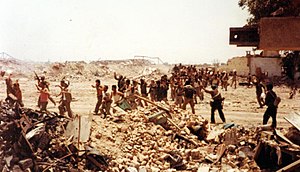Battle of Khorramshahr (1982): Difference between revisions
IbrahimWeed (talk | contribs) m IbrahimWeed moved page Liberation of Khorramshahr to Second Battle of Khorramshahr: The naming shows a little bit of bias towards Iran |
|
(No difference)
| |
Revision as of 09:56, 8 August 2020
| Liberation of Khorramshahr | |||||||||
|---|---|---|---|---|---|---|---|---|---|
| Part of the Iran–Iraq War | |||||||||
 Iraqi prisoners of war | |||||||||
| |||||||||
| Belligerents | |||||||||
|
|
| ||||||||
| Commanders and leaders | |||||||||
|
|
| ||||||||
| Strength | |||||||||
| 70,000 | 70,000 | ||||||||
| Casualties and losses | |||||||||
|
15,000 killed and wounded 15,000–19,000 captured 550 tanks and armoured vehicles destroyed 105 tanks and armoured vehicles captured | 30,000 killed and wounded | ||||||||
The Liberation of Khorramshahr (Persian: آزادسازی خرمشهر Âzâdsâzī-ye Khorramshahr) was the Iranian recapture of the port city of Khorramshahr from the Iraqis on 24 May 1982, during the Iran–Iraq War. The Iraqis had captured the city early in the war on 26 October 1980.[1][2] The successful retaking of the city was part of Operation Beit ol-Moqaddas. It is perceived as a turning point in the war and the liberation is celebrated in Iran on its anniversary, 24 May.[3]
Battle
The city remained in Iraqi hands until April 1982, when the Iranians launched Operation Beit ol-Moqaddas to recapture the Khuzestan province. The first attack (from 24 April to 12 May 1982) utilized approximately 70,000 Iranian army troops and Revolutionary Guards that succeeded in pushing the Iraqi forces out of the Ahvaz-Susangerd area while sustaining heavy casualties. The Iraqis withdrew back to Khorramshahr and, on 20 May, launched a heavy but unsuccessful counterattack against the Iranians who stood their ground no matter the cost. An all-out assault on Khorramshahr was then launched by Iran, which captured two Iraqi defense lines in the Pol-e No and Shalamcheh region. The Iranians gathered near the Shatt al-Arab (known as Arvand Rud in Iran) waterway, surrounded the city and began a second siege. The Iranians finally recaptured the city on 24 May 1982 after two days of bitter fighting and heavy losses.[3][4]
Aftermath

In re-taking the city, the Iranians captured approximately 19,000 soldiers from a demoralized Iraqi Army. On the other hand, Saddam Hussein was shocked and furious by the defeat in Khorramshahr and at the fact that the Iranians had pushed on despite sustaining heavy casualties. The Iranians had even been forced to commit their reserves in order to keep on driving back the Iraqis. Iranians had shown incredible determination. After the defeat at Khorramshahr, Saddam Hussein executed several of his top generals, such as the commander of the 9th Division.[3]
Calls for a ceasefire in the Iran–Iraq War were made three days[5] after the liberation of Khorramshahr, and officials of both countries began discussing such a possibility.[6]
Iranians celebrate the anniversary of the liberation of Khorramshahr every year.[2][7]
The Iranians have also named their indigenous air defense system 3rd Khordad after the battle[8].
In popular media
The Liberation of Khorramshahr had been the subject that get the attention of some war time city films such as the pasdaran Army Television Unit's recapturing Khorramshahr in 1983, Another Growth by Homayun Purmand in 1982, Forty witnesses and the second narrative:[9] liberation of Khorramshahr by Kiumarth Monazzah.[10]
A popular sad Persian song, "Mammad Naboodi" (ممد نبودی, meaning "Mammad [colloquial variant of Mohammad], you were not there [to see the city has been liberated]") by Gholam Koveitipoor is about Mohammad Jahanara, the Pasdaran commander who was one of the last few Iranians to leave Khorramshahr when it fell to the Iraqis. He would go on to fight in the Siege of Abadan and lead Iranian forces to recapture Khorramshahr, but he died on May 24, in a plane crash, before the eventual liberation of the city.[11]
See also
- Karun River
- Chess with the Doomsday Machine
- Eternal Fragrance
- Noureddin, Son of Iran
- One Woman's War: Da (Mother)
References
- ^ Naraghi, Ehsan (193). From Palace to Prison: Inside the Iranian Revolution. Ivan R. Dee, publisher. ISBN 978-1566630337.
- ^ a b Staff, Writer. "Iran celebrates anniversary of liberating Khorramshahr". Alalam.
- ^ a b c Murray, Williamson; Woods, Kevin M. (2014). The Iran-Iraq War: A Military and Strategic History. Cambridge University Press. ISBN 978-1-107-67392-2.
- ^ Razoux, Pierre; Elliott, Nicholas (2015). The Iran-Iraq War. Belknap Press. ISBN 978-0674088634.
- ^ Blight, James G.; Lang, Janet M.; Banai, Hussein; Byrne, Malcolm; Tirman, John (2014). Becoming Enemies: U.S.-Iran Relations and t. Rowman & Littlefield Publishers. ISBN 978-1-4422-0831-5.
- ^ Sinkaya, Bayram (2015). The Revolutionary Guards in Iranian Politics: Elites and Shifting Relations. Routledge. ISBN 978-1-138-85364-5.
- ^ Staff, writer. "Iran-Iraq War off-limits to historians in Iran". al-monitor.
- ^ Binnie, Jeremy (13 July 2014). "IRGC unveils new tactical ballistic missiles developments - IHS Jane's 360". London. Archived from the original on 14 July 2014.
- ^ Leaman, Oliver (2014). Companion Encyclopedia of Middle Eastern and North African Film. Routledge. ISBN 978-0415757553.
- ^ Naficy, Hamid (2012). A Social History of Iranian Cinema, Volume 4: The Globalizing Era, 1984–2010. Duke University Press Books. p. 664. ISBN 978-0822348788.
- ^ McLaurin, R. D. (July 1982). "Military Operations in the Gulf War: The Battle of Khorramshahr" (PDF). U.S. Army Human Engineering Laboratory: 24. Retrieved 25 August 2012.
{{cite journal}}: Cite journal requires|journal=(help)
External links
- Khorramshahr Battle Continues (Video)
